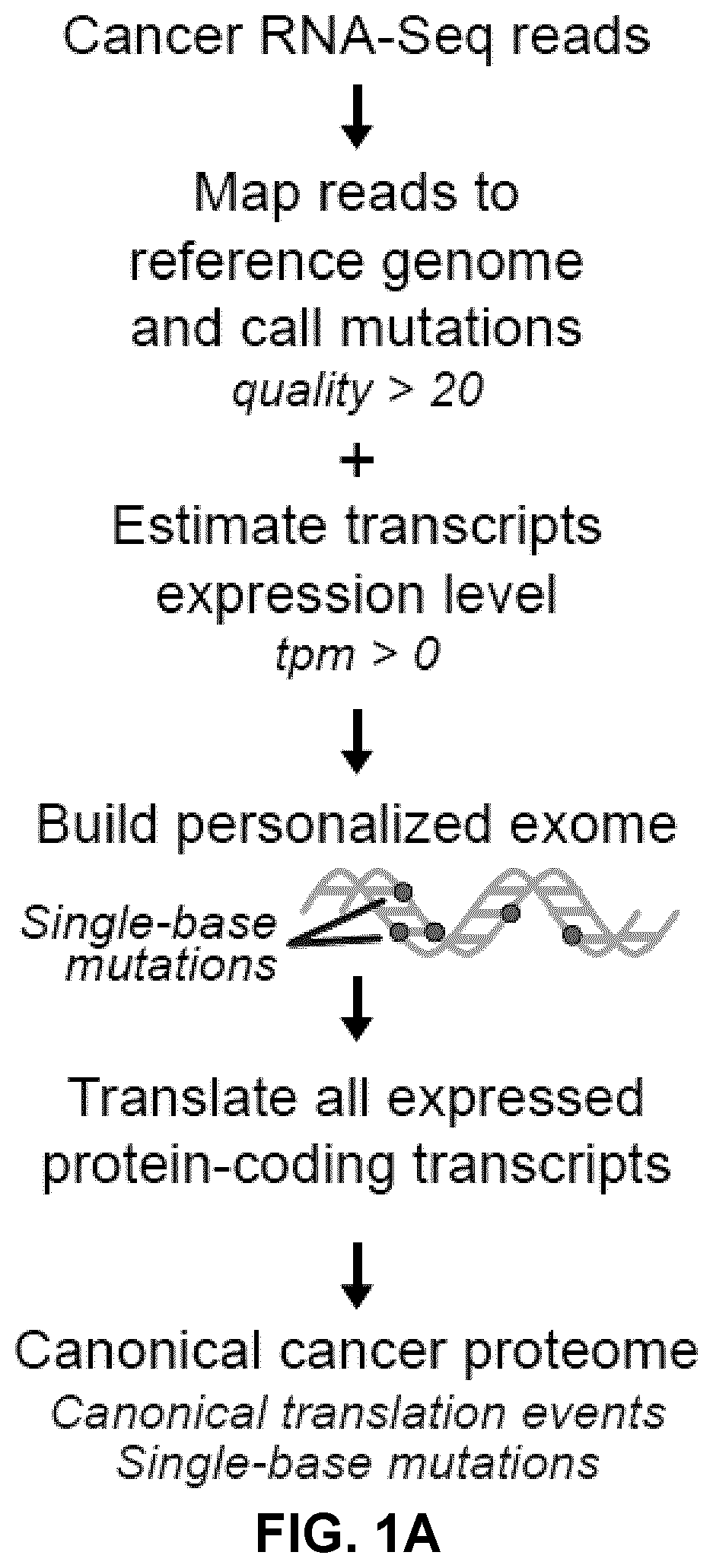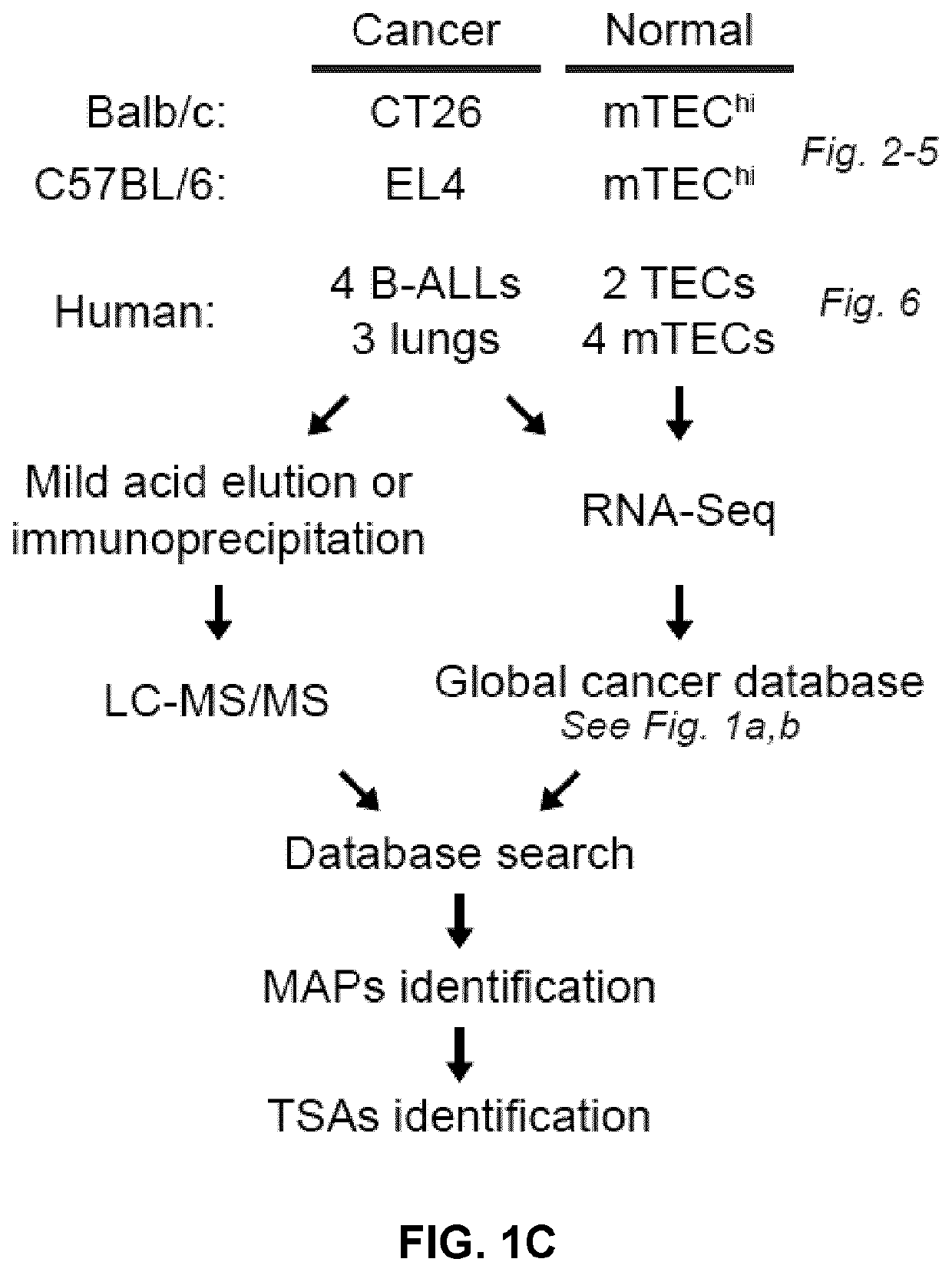Proteogenomic-based method for identifying tumor-specific antigens
a proteogenetic and tumor-specific technology, applied in the field of cancer, can solve the problems of focusing on the exome as the only source of tsas, and unable to identify tsas with exon mutations,
- Summary
- Abstract
- Description
- Claims
- Application Information
AI Technical Summary
Benefits of technology
Problems solved by technology
Method used
Image
Examples
example 2
Rationale and Design of a Proteogenomic Method for TSA Discovery
[0247]Attempts to computationally predict TSAs using various algorithms are fraught with exceedingly high false discovery rates27. Hence, systems-level molecular definition of the MAP repertoire can only be achieved by high-throughput MS studies3. Current approaches use MS / MS software tools, such as Peaks28, which rely on a user-defined protein database to match each acquired MS / MS spectrum to a peptide sequence. Since the reference proteome does not contain TSAs, MS-based TSA discovery workflows must use proteogenomic strategies to build customized databases, derived from tumor RNA-sequencing (RNA-Seq) data29, that should ideally contain all proteins, even unannotated ones, expressed in the considered tumor sample. As current MS / MS software tools cannot deal with the large search space created by all-frame translating all RNA-Seq reads30,31, a proteogenomic strategy enriching for cancer-specific sequences was devised i...
example 3
Non-Coding Regions are the Main Source of TSAs
[0248]At 5% false discovery rate, 1,875 MAPs on CT26 cells and 783 MAPs on EL4 cells were identified. Among those, MAPs absent from the mTEC' proteome were considered as TSAs candidates if (i) their 33-nucleotide-long MAP-coding sequence (MCS), derived from a full cancer-restricted 33-nucleotide-long k-mers, was absent from the mTEChi transcriptome or if (ii) their 24-to-30-nucleotide-long MCS, derived from a truncated version of a cancer restricted 33-nucleotide-long k-mers, was overexpressed by at least 10-fold in the transcriptome of cancer vs. mTEChi cells (FIG. 8A). Following MS-related validation steps and assignment of a genomic location (FIG. 8B-C), a total of 6 mTSAs and 15 aeTSA candidates were obtained: 14 presented by CT26 cells and 7 by EL4 cells (FIG. 2A-B). MAPs that were both mutated and aberrantly expressed were included in the mTSA category. All these MAPs are believed to be novel and are absent from the Immune Epitope ...
example 4
Frequency of TSA-Specific T Cells in Naive and Immunized Mice
[0251]In various models, the strength of in vivo immune responses is regulated by the number of antigen-reactive T cells44,46. The frequency of TSA-specific T cells in naive and immunized mice was therefore assessed using a tetramer-based enrichment protocol46,47, for which the gating strategy and one representative experiment can be found in FIGS. 9A-C. As positive controls, the highly abundant CD8 T cells specific for three viral epitopes (gp-33, M45 and B8R) was used, and it was confirmed that their frequency was within range of those observed in previous studies45 (FIG. 4A). In naive mice, CD8 T cells specific for TVPLNHNTL, VTPVYQHL and IILEFHSL were rare (less than one tetramer+ cell per 106 CD8 T cells), while CD8 T cells specific for the ERE TSAs (VNYIHRNV and VNYLHRNV) displayed frequencies similar to those of the viral controls (FIG. 4A and FIG. 10A). Accordingly, in mice immunized with TSA-pulsed DCs, it was fou...
PUM
| Property | Measurement | Unit |
|---|---|---|
| Fraction | aaaaa | aaaaa |
| Mass | aaaaa | aaaaa |
| Mass | aaaaa | aaaaa |
Abstract
Description
Claims
Application Information
 Login to View More
Login to View More - R&D
- Intellectual Property
- Life Sciences
- Materials
- Tech Scout
- Unparalleled Data Quality
- Higher Quality Content
- 60% Fewer Hallucinations
Browse by: Latest US Patents, China's latest patents, Technical Efficacy Thesaurus, Application Domain, Technology Topic, Popular Technical Reports.
© 2025 PatSnap. All rights reserved.Legal|Privacy policy|Modern Slavery Act Transparency Statement|Sitemap|About US| Contact US: help@patsnap.com



